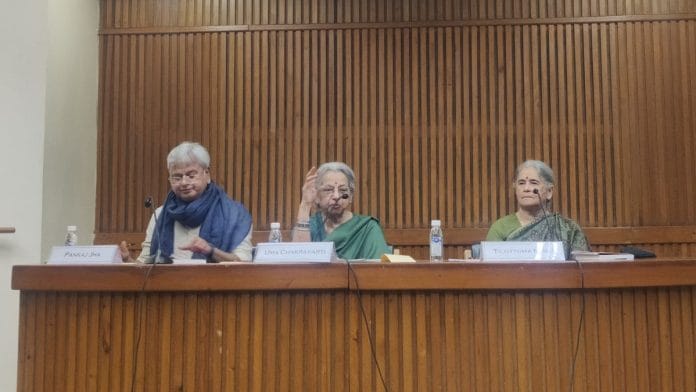New Delhi: Thirty-seven years after poet AK Ramanujan wrote the controversial Three Hundred Ramayanas essay, here is another new book about the Assamese Ramayana. This one has Sita comparing Ram’s tongue to one that turns rice into puffed rice. She calls out Ram’s corruption and chooses her dignity over his kingdom. She even calls him a ‘rakshasa (demon) incarnate’.
The book, Sita’s Voice in the Assamese Ramayana, by critic and translator Tilottoma Misra, has translated verses from 14th-century Assamese poet Madhava Kandali’s Saptakanda Ramayana and 15th-century polymath Srimanta Sankaradeva’s Uttara Kanda Ramayana.
“In the Assamese version, Sita stands before the audience, her words powerful and passionate, as she speaks her heart out, especially in the Uttara Kanda. She challenges the patriarchal norms and speaks forcefully about her feelings,” said Misra, during a discussion on her book at the India International Centre (IIC) on 18 November.
The event, moderated by Pankaj Jha, assistant professor at Delhi University, explored how different versions of the Ramayana challenge traditional patriarchal norms, with Sita emerging as a defiant and outspoken figure.
“We’re surrounded by a metaphorical Lakshman Rekha, drilled into us year after year through tradition and performances like Ramlila. But it’s not there—it’s something we’ve been conditioned to believe,” said historian and filmmaker Uma Chakravarti, who was part of the panel.
Language of the people
Madhava Kandali’s Saptakanda Ramayana was written in the 14th century and commissioned by Mahamanikya, a Barahi Kachari ruler from present-day Assam. It is one of the earliest Assamese adaptations of the epic, predating other famous versions in North India, like those by Krittibas and Tulsidas from the 15th and 16th centuries, respectively.
But his work remained incomplete, with the Bala Kanda and Uttara Kanda missing. In the 15th–16th century CE, Srimanta Sankaradeva, completed the work by adding these sections.
“He called Madhava Kandali his unparalleled predecessor and flawless. However, he noted that his text lacked the Bhakti element, and could not be considered a religious work,” said Misra.
Sankaradeva preserved Madhava Kandali’s original verses but added Bhakti elements at the beginning and end of each Kanda. His disciple, Madhavadeva, translated the Bala Kanda, completing the Assamese Ramayana as a collaboration of Madhava Kandali, Madhavadeva, and Sankaradeva.
Sankaradeva described the text as “not the language of the gods, but the language of the people. It belongs to no one and everyone.” The text reflects the local culture, oral traditions, and the community’s influence, contributing to the rise of a composite culture.
“Sankaradeva and Madhavadeva came 100 years after Madhava Kandali, but they never wanted to call their text a separate text. They just wanted to add to the original one,” said Misra.
The Assamese Ramayana was not just a text; it was a cultural movement. Its creation reflected the power of vernacular literature to unify people, and its legacy lived on, not as a single author’s masterpiece, but as the collaborative soul of a region.
“I don’t call it the Ahomya Ramayana because Assam, as a colonial province, came later. I prefer to call it the Assamese Ramayana,” said Misra, reflecting on the broader cultural identity of the region.
Also read: Mohinder Amarnath plays bold in his ‘Fearless’ memoir. Picks Imran Khan over Gavaskar
Sita’s defiance
One of the most striking scenes in the Assamese Ramayana is when Sita bids farewell to the world. In Valmiki’s text, Sita is a woman of few words, dignified and reserved, speaking only when necessary. But in the Assamese version, Sita stands before the audience, her words powerful, emotional and passionate, as she speaks her heart out.
“Sankaradeva, a dramatic artist, likely drew on his theatrical skills to create Sita’s powerful image—standing before the audience like a newly risen moon, clad in sannyasi garments,” said Misra.
In Valmiki’s Ramayana, he created strong, powerful characters, particularly the three brothers, Bharata, Lakshman, and Ram. Lakshman is portrayed as the embodiment of loyalty, following Ram to the forest and enduring countless hardships by his side.
When Sita gets abducted, Ram and Lakshman, desperate to find her, discover a bundle of jewels.
“This is her kardhani ornament,” Ram excitedly tells his brother. But Lakshman picks out only the payal (anklet), saying, “This is the only thing I recognise because my eyes have never looked higher than her feet.”
In a lesser-known version from UP, Sita’s interaction with her sister-in-law, Shanta, offers a fresh take on the Ramayana. Shanta asks Sita about her time with Ravana, and in a moment of curiosity and defiance, Sita, despite her hesitations, draws an outline of Ravana’s face in the dirt. This act—seeing and remembering Ravana’s face—symbolises a significant transgression, breaking the ideal of a ‘pure’ woman.
When Ram hears of this, he reacts not as a king but simply as a jealous husband, furious over Sita’s actions.
“Lakshman recognised nothing but the payal, and Sita not only saw Ravana’s face but remembered it and drew it,” said Chakravarti, highlighting the contrast between Lakshman’s loyalty and Sita’s breach of societal expectations.
“In Misra’s translation of Madhava Kandali’s Ramayana, Sita’s anger is initially shown, but eventually folded back, as though her feelings are sanitised to restore the original narrative,” Chakravarti explained.
(Edited by Aamaan Alam Khan)






